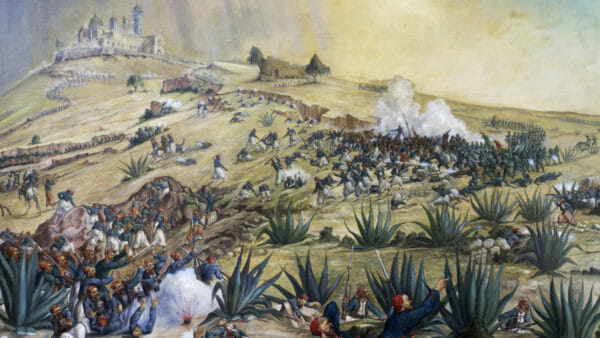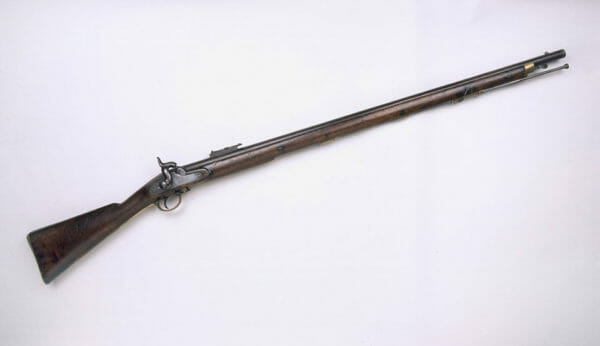The Guns of Cinco de Mayo – Mexico’s Victory Over French Forces
Forum Information
You will earn 1.5 pts. per new post (reply) in this forum.
**Registered members may reply to any topic in this forum**
You will earn 1.5 pts. per new post (reply) in this forum.
**Registered members may reply to any topic in this forum**
-
NHGF [Feed]

- Posts: 17274
- Joined: Mon Oct 30, 2017 5:16 pm
- Contact:
- Status: Offline
 Battle of Puebla, May 5, 1862Puebla, Mexico -(AmmoLand.com)- It’s not uncommon for people to mistake Cinco de Mayo as a day to celebrate Mexico’s independence, but that’s actually September 16, 1810. Instead, Cinco de Mayo celebrates Mexico’s May 5, 1862, victory over French forces in Puebla City. In 1861, Mexico had just ended a civil war and was in a financially ruinous state. As a result, President Juarez suspended all payments of foreign debt. France, Great Britain, and Spain were owed significant sums of money and they were not pleased with this decision, so the three countries banded together to demand repayment. By early 1862, Mexico had convinced Great Britain and Spain to stand down with the promise of future payments. However, France was undeterred and their troops remained on Mexican soil. War was inevitable.
Battle of Puebla, May 5, 1862Puebla, Mexico -(AmmoLand.com)- It’s not uncommon for people to mistake Cinco de Mayo as a day to celebrate Mexico’s independence, but that’s actually September 16, 1810. Instead, Cinco de Mayo celebrates Mexico’s May 5, 1862, victory over French forces in Puebla City. In 1861, Mexico had just ended a civil war and was in a financially ruinous state. As a result, President Juarez suspended all payments of foreign debt. France, Great Britain, and Spain were owed significant sums of money and they were not pleased with this decision, so the three countries banded together to demand repayment. By early 1862, Mexico had convinced Great Britain and Spain to stand down with the promise of future payments. However, France was undeterred and their troops remained on Mexican soil. War was inevitable.  Baker rifle illustration, ca. 1803 (wikipedia)The battle at Puebla involved approximately 11,000 soldiers: 4,500 Mexicans commanded by Ignacio Zaragoza and 6,000-6,500 French commanded by Charles de Lorencez. When the dust settled, Mexico had won, with France sustaining a casualty ratio of 5:1. The guns and other arms used by both sides have been the subject of debate and speculation for years. There are very few first-hand accounts of the battle, and even fewer in English, which make this kind of research no easy task. Make no mistake: this piece will not definitively settle what was used there, but it will give some insight as to what might have been there – and you’ll probably be surprised by some of the items listed here. Mexican Forces Puebla was fairly well-fortified, with two different forts nearby providing artillery coverage. The types of cannons used are unknown, but they most likely would have been a mix of older smoothbore guns of various sizes firing both solid shot and grapeshot. Their infantry would likely have still been armed with a wide variety of British surplus arms that had been purchased in the previous decades. This could have included any number of flintlock “Brown Bess” smoothbore muskets and P1800 flintlock “Baker” rifles. Percussion conversions of earlier flintlock arms and even some percussion production guns would also have been likely candidates at this time. For example, a photo of the firing squad that executed French-installed Emperor Maximilian I of Mexico in 1867 show the men posing with percussion arms fixed with bayonets. While this incident takes place five years later, it’s unlikely that a massive step forward in arms had taken place during that time, especially given the conflict that was gripping the country.
Baker rifle illustration, ca. 1803 (wikipedia)The battle at Puebla involved approximately 11,000 soldiers: 4,500 Mexicans commanded by Ignacio Zaragoza and 6,000-6,500 French commanded by Charles de Lorencez. When the dust settled, Mexico had won, with France sustaining a casualty ratio of 5:1. The guns and other arms used by both sides have been the subject of debate and speculation for years. There are very few first-hand accounts of the battle, and even fewer in English, which make this kind of research no easy task. Make no mistake: this piece will not definitively settle what was used there, but it will give some insight as to what might have been there – and you’ll probably be surprised by some of the items listed here. Mexican Forces Puebla was fairly well-fortified, with two different forts nearby providing artillery coverage. The types of cannons used are unknown, but they most likely would have been a mix of older smoothbore guns of various sizes firing both solid shot and grapeshot. Their infantry would likely have still been armed with a wide variety of British surplus arms that had been purchased in the previous decades. This could have included any number of flintlock “Brown Bess” smoothbore muskets and P1800 flintlock “Baker” rifles. Percussion conversions of earlier flintlock arms and even some percussion production guns would also have been likely candidates at this time. For example, a photo of the firing squad that executed French-installed Emperor Maximilian I of Mexico in 1867 show the men posing with percussion arms fixed with bayonets. While this incident takes place five years later, it’s unlikely that a massive step forward in arms had taken place during that time, especially given the conflict that was gripping the country.  Emperor Maximilian's firing squad (wikipedia)Cavalry forces at Puebla would have likely carried lances and any number of British or US-made sabers and swords. It’s also not outside the realm of possibility that some Colt percussion revolvers were also present at the battle. This would include the Model 1851 Navy as the most likely candidate, but there might have also been a smattering of earlier Dragoon pistols – and maybe even a Walker or two. French Forces French Zouave infantrymen would likely have carried P1851 Minié rifles, which were .70-caliber muzzleloading percussion-ignition rifles very similar to the smaller .58-caliber P1853 Enfield and M1861 Springfield guns used on both sides during the American Civil War of the same period. Another likely candidate for longarms was the M1859 Chasseur rifle, a .69-caliber percussion rifle developed and manufactured throughout France.
Emperor Maximilian's firing squad (wikipedia)Cavalry forces at Puebla would have likely carried lances and any number of British or US-made sabers and swords. It’s also not outside the realm of possibility that some Colt percussion revolvers were also present at the battle. This would include the Model 1851 Navy as the most likely candidate, but there might have also been a smattering of earlier Dragoon pistols – and maybe even a Walker or two. French Forces French Zouave infantrymen would likely have carried P1851 Minié rifles, which were .70-caliber muzzleloading percussion-ignition rifles very similar to the smaller .58-caliber P1853 Enfield and M1861 Springfield guns used on both sides during the American Civil War of the same period. Another likely candidate for longarms was the M1859 Chasseur rifle, a .69-caliber percussion rifle developed and manufactured throughout France.  Lefaucheux M1858 revolverTheir Sappers were considerably less well-equipped. Some carried boards with rungs nailed to them, which were “clearly insufficient for the task but the only things that could be obtained in haste.” Others carried bags of gunpowder that were to be used to blow the gates of the redoubt. Their artillerymen would have likely been manning “Canon de l'Empereur,” which we know today as “Napoleon” or “12-pounders.” They were high-tech at the time and could deal serious blows to the enemy defenses and their soldiers. French cavalry are known to have carried a limited number of the Lefaucheux M1858 revolver. This gun was based on designs created by French gunsmith Casimir Lefaucheux. The M1858 was developed for the French navy and fired a 12mm pinfire cartridge. Interestingly, though the revolver was used by the French navy and cavalry, it was never officially issued to their army.
Lefaucheux M1858 revolverTheir Sappers were considerably less well-equipped. Some carried boards with rungs nailed to them, which were “clearly insufficient for the task but the only things that could be obtained in haste.” Others carried bags of gunpowder that were to be used to blow the gates of the redoubt. Their artillerymen would have likely been manning “Canon de l'Empereur,” which we know today as “Napoleon” or “12-pounders.” They were high-tech at the time and could deal serious blows to the enemy defenses and their soldiers. French cavalry are known to have carried a limited number of the Lefaucheux M1858 revolver. This gun was based on designs created by French gunsmith Casimir Lefaucheux. The M1858 was developed for the French navy and fired a 12mm pinfire cartridge. Interestingly, though the revolver was used by the French navy and cavalry, it was never officially issued to their army.  P1851 Minie rifle (NAM)Epilogue It wasn’t until 1867 that the conflict of which the battle of Puebla and the inspiration for Cinco de Mayo officially ended and Mexico returned to republican government. In 1876, Porfirio Díaz- who had commanded the cavalry at Puebla – ran a successful campaign for president and held the office for eight terms until 1911, making him the longest-serving president in the country’s history. So there you have it: the true origin of Cinco de Mayo lies with a battle during a conflict more than half a century after Mexican independence.
P1851 Minie rifle (NAM)Epilogue It wasn’t until 1867 that the conflict of which the battle of Puebla and the inspiration for Cinco de Mayo officially ended and Mexico returned to republican government. In 1876, Porfirio Díaz- who had commanded the cavalry at Puebla – ran a successful campaign for president and held the office for eight terms until 1911, making him the longest-serving president in the country’s history. So there you have it: the true origin of Cinco de Mayo lies with a battle during a conflict more than half a century after Mexican independence. About Logan Metesh
 Logan Metesh is a historian with a focus on firearms history and development. He runs High Caliber History LLC and has more than a decade of experience working for the Smithsonian Institution, the National Park Service, and the NRA Museums. His ability to present history and research in an engaging manner has made him a sought after consultant, writer, and museum professional. The ease with which he can recall obscure historical facts and figures makes him very good at Jeopardy!, but exceptionally bad at geometry.
Logan Metesh is a historian with a focus on firearms history and development. He runs High Caliber History LLC and has more than a decade of experience working for the Smithsonian Institution, the National Park Service, and the NRA Museums. His ability to present history and research in an engaging manner has made him a sought after consultant, writer, and museum professional. The ease with which he can recall obscure historical facts and figures makes him very good at Jeopardy!, but exceptionally bad at geometry.